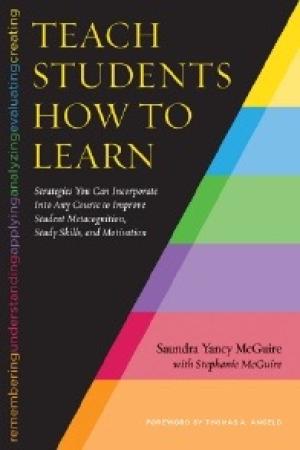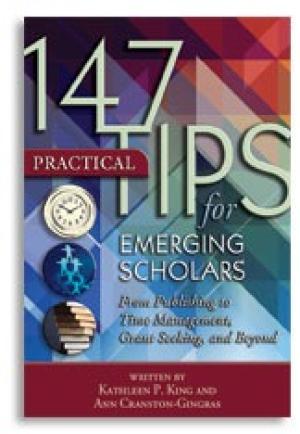Resources by Whitney Cox

It shouldn’t be surprising that a volume intent on teaching students how to learn is just as intent on teaching the reader how to do just that, but it is still refreshing to read a book that lays out its goals, sticks to the promises it makes, and even creates its own study guide based on how much time the reader has to give to the text. Well-structured and clear, Saundra Yancy McGuire’s Teach Students How to Learn is as thoughtful about itself as it is about the content it presents. McGuire has composed this book to reflect her own response to and engagement with a pressing problem in higher education: namely, that many students, even those who qualify for admission at prestigious institutions, arrive without ever having been taught to learn by anything but rote memorization. Faced with college’s demands of skills higher in Bloom’s Taxonomy, they find themselves struggling and even failing. With this book McGuire gives teachers the tools they need to move their students past the high school model of retention until regurgitation, helping them instead to internalize a more nuanced, flexible understanding of learning. To convey this understanding, McGuire focuses on student mindset, encouraging educators to bring in everything from neurobiological models to fellow student success stories in order to help learners see that they are not stuck being “bad” at something – that change is not only possible, but already well within reach. One potentially significant drawback, depending on one’s perspective, is how the techniques are not out-of-the-box geared to address the concerns of humanities classes. Despite the fact that most of her experience comes from teaching chemistry – and how, relatedly, most of the examples in this book are from students of the sciences – McGuire insists that the techniques here are useful outside of STEM fields. While I have no difficulty believing that claim, it is clear that most of the methods in the book are geared toward content-focused disciplines. Fortunately, McGuire’s significant focus on critical and creative thinking on top of factual learning makes these strategies flexible and worth adapting. Most of all, McGuire is a fun writer. Personal and plainspoken, her style makes the pages fly by. (Any worries that this book might drown the reader in jargon should be alleviated by the appearance of the words “metacognition, schmetacognition” [17].) While perhaps not the most sophisticated text on the subject, Teaching Students How to Learn has hints and information appropriate to instructors at all levels of familiarity with metacognitive concepts, including none at all. I would recommend this book in particular to educators working with students from underserved communities, as giving students access to these techniques will help ensure their success far beyond the boundaries of a single classroom.

The authors of 147 Practical Tips for Emerging Scholars describe their work as offering much “to initiate or advance your success as a scholar, and nothing to lose as you invest a short time to read it” (22). This is a bold claim for a slender volume. However, this clear, honest, unpretentious work lives up to that promise. Authors Kathleen King and Ann Cranston-Gingras identify a key problem with the structure of academia: Those who seek to engage with it too often find themselves without guidance: the professional lives of doctoral faculty, new faculty, and experienced faculty (the three groups the book addresses) are often unsupervised and lack critical guidance for developing and establishing professional reputations, maintaining schedules, pursuing tenure, and avoiding mistakes. Guidance for making good professional decisions is what 147 Practical Tips seeks to provide. The key word which characterizes these tips is “practical”; the tips range from advice about scheduling to reminders to spell-check all correspondence. Some of the tips are about personal development; the authors focus not just on writing, but writing well, learning to vary styles and approaches. Others concern etiquette, with the dos and don’ts of collaborating with peers and contacting publication editors. The final section encourages scholars to apply this knowledge in the service of other emerging scholars, becoming the mentors to students and colleagues we wish we had had. Throughout, there is the acknowledgment that not all of the tips are relevant to all persons at all times; instead, King and Cranston-Gingras intend this to be a re-read resource, to be returned to as often as necessary. Though both authors work in education departments, the tips are meant to be applicable across disciplines – which is one of the book’s unfortunate weaknesses, as most tips are by necessity wholly unspecific. In addition, the section on technology already feels a touch outdated, as though it were targeted to an older audience, one which could use reminders that Dropbox can facilitate collaboration and all-caps text reads like shouting. For a short, cross-discipline guidebook, however, this book provides a significant amount of helpful hints and general guidance. Even in its limited scope, it encourages readers to take the extra steps they need to learn about publications, trends, and significant works inside their own disciplines, and then to apply the information here as necessary. The advice is often simple but rarely simplistic; even the most basic suggestions are good reminders of things too easy to forget in what can be chaotic pursuits. An emerging scholar myself, I would recommend this book to others on the path to establishing academic careers, and I expect to find myself opening it again.